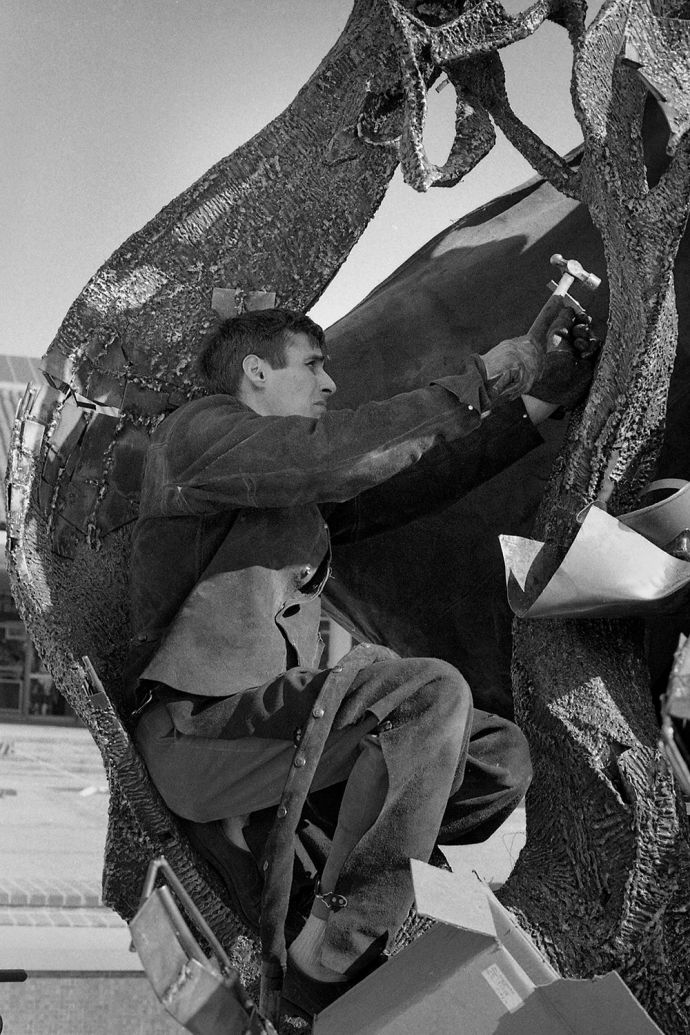Sculptor Aristides “Aris” Demetrios had just stepped out of his waders after sloshing around White Memorial Fountain with a restoration crew when a group of bathing-suit-clad students politely asked if he would mind them using the shallow pool for an annual ritual.

Sculptor Aristides Demetrios, who designed and fabricated White Memorial Fountain, conducts a Stanford crew restoring the fountain in 2010. (Image credit: L.A. Cicero)
To everyone’s amusement, including a smiling Demetrios, who wore a Stanford cap over his white hair, the students stood in a circle around the iconic fountain and performed a synchronized swim routine of sorts that ended when they dunked their “conductor.”
Demetrios, whose art career spanned six decades, died Dec. 12 in Santa Barbara, California, where he lived with his wife, Ilene Nagel, SLS, ’85. He was 89.
The welded bronze and copper fountain is affectionately known to generations of Stanford students, faculty and staff as The Claw. The 16-foot-tall fountain stands between Old Union and the Stanford Bookstore in a shallow pool with blue-tiled walls. Four curved cement benches frame the corners of the pool.
In a recent interview with Stanford Daily, Nagel said her husband’s work always held a lighthearted character and his goal in life was to make people feel something positive the moment they came into contact with his art. He wanted everyone to be playful with his sculptures, she said.
At Stanford, students wade, hop, dance and dangle their feet in the fountain, which is a regular stop for the Leland Stanford Junior University Marching Band, the Stanford Tree and the Stanford Dollies when they roam campus entertaining students during Dead Week.
Every autumn, students impale a stuffed bear – representing the UC Berkeley mascot Oski – on the highest peak of the sculpture in the days leading up to the Big Game.

Sculptor Aristides Demetrios, who won a national competition to design and create White Memorial Fountain, installing the sculpture in 1964. (Image credit: Chuck Painter)
The sculpture was commissioned to honor two Stanford students, brothers who died in separate accidents before they could graduate with the Class of 1949. Their parents, Mr. and Mrs. Raymond B. White, donated money for White Memorial Plaza and the fountain.
“The tragedy of someone dying so young is that you never know what they might have become,” Demetrios told Stanford Report in October 2010. “The fountain is a metaphor for that. It starts in bronze, which is firm, durable and set in place. It terminates in water patterns that are diaphanous and mutable – the very reverse of anything solid. It speaks to what they might have become. When I told their father that, he burst into tears.”
Demetrios was in his early 30s when he won the commission to design and fabricate the sculpture, after submitting three designs that came in first, second and third in the national competition.
In August 2010, Demetrios told Stanford Report that his son, Eames, who was about 2 years old at the time, grew up in the studio where he fabricated White Memorial Fountain.
“I noticed that some small pieces of bronze were missing in the studio, but I didn’t think much of it,” he said. “I got the fountain in place at Stanford and turned it on. It just shook. And shook. And shook. Finally, all these little pieces of bronze came shooting out of the waterspouts. It was like being in the Blitz – we were dodging all these pieces of shrapnel. My son had dropped the pieces into the waterspouts. We just roared with laughter.”
In June 2011, Demetrios returned to campus to help campus plumbers and machinists “fine tune” the fountain’s five dozen valves to ensure they coated the entire sculpture with water. As he walked around the fountain, he pronounced their work “fantastic.”
“See the droplets of water glistening in the sun in the center,” Demetrios said. “They weren’t there before. This is a ball and now the water expresses it. Look at the water dance on top. It’s full of life and spirit.”